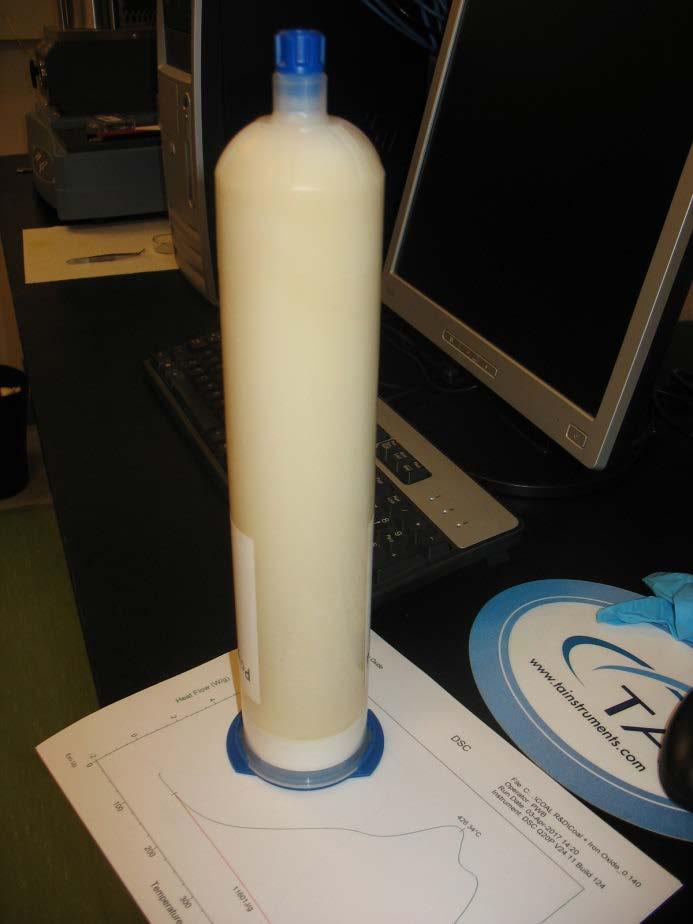
13 minute read
The Preparation of a Polyurea Grease Using mPAO 65 and Preformed Diurea
Abstract:
Paul A. Bessette* and Ken Hope** *Triboscience & Engineering, Inc., Fall River, MA 02742 **Chevron Phillips Chemical Co., LP, The Woodlands, TX 77380
Introduction:
This paper provides a simple example of the use of mPAO 65 (metallocene polyalphaolefin oil, kinematic viscosity = 65 cSt at 100°C) and a preformed polyurea thickener to produce a polyurea grease. The ease of manufacturing using a preformed thickener is highlighted as well as the excellent properties that are obtained from the mPAO base oil. NLGI grade 2 grease was prepared in the absence of additives and therefore represents a base grease that provides a starting point for further formulation. The low temperature properties of this base grease are an advantage even though polyurea greases are typically known for high temperature advantages over lithium and calcium types of thickener systems. Rheological data clearly demonstrates the superior behavior of this mPAO 65 based grease. Between -30 and -40°C, viscosity was significantly lower than a polyurethane grease formulated with ISO 220 mineral oil. Dropping point (> 260°C), oxidation induction time (14.49 min at 180°C) and temperature for 5% weight loss (294°C) were impressive at high temperatures. Therefore, this grease may be suitable for formulations intended for applications over a wide temperature range. In addition, the apparent viscosity data suggest that this grease has potential to help to prevent fretting corrosion. Polyurea greases are thickened with polyurea, and differ from other types of greases that are thickened with a soap or soap complex. The use of polyureas as thickeners in greases was reported initially in the 1950s [1-4]. The usefulness of these greases is due to the advantages of their high temperature performance properties, oxidative stability, water resistance, elastomer compatibility, pumpability and long bearing life [5]. Particular use has been found in rolling element bearings in electric motors, wheel bearings, spindles, constant velocity joints and even food grade applications.
A polyurea grease has a very different composition compared to other thickener types in that it is a low molecular weight polymer that is formed in the base oil. Therefore, these non-soap thickeners are more accurately considered as gel-like in nature. The gel thickener chemistry of the polyurea requires two types of chemicals: 1) isocyanates and 2) amines. The polymerization of these two components gives rise to the formation of the gel distributed in the base oil.
The chemistry of these polymers is different from other soap type thickeners since they possess a useful advantage of not being a metal salt of a fatty acid [5]. In soap thickened
greases, materials like lithium or calcium might affect the high temperature properties of a grease since they could act as catalysts for thermo-oxidative degradation of the base oil. Conversely, polyurea greases contain no metal ions from thickeners, providing a benefit for high temperature applications since there are no cations to induce catalytic degradation. Moreover, polyurea greases exhibit desirable rheological characteristics for applications susceptible to fretting wear. These greases also are noted for high dropping points and little tendency for oil separation.
These beneficial properties of polyurea grease come at the expense of the handling requirements of the components mentioned earlier, isocyanates and amines, which are considered extremely hazardous. According to Ivanhoe Industries Inc. [6], “the starting isocyanates and amines are highly toxic and require special handling equipment to handle safely.” Many grease suppliers or those that wish to produce these greases may lack the equipment and depend upon third party manufacturers to produce the polyurea grease. Safely producing the grease is all the more important as companies rightly strive toward zero safety incidents.
Given the potential consequences of working with isocyanates, it raises the question of whether there is a better way to make polyurea greases in a safer manner. This question was answered by researchers at Bayer Ag., specifically, Christian Rasp and co-workers in 1994 [7]; they described a three-step process that was employed to make a polyurea powder for the preparation of polyurea greases. Manufacturing the powder still requires the use of the hazardous chemicals, but once the powder is produced and supplied to grease manufacturers, the need to work with hazardous chemicals is minimized or eliminated altogether. The primary purpose of this study was to make a polyurea grease from two relatively novel raw materials, measure its properties and assess this technology for industrial applications. Base grease was prepared from metallocene polyalphaolefin (mPAO) base stock and preformed diurea thickener. The unadditized base grease was evaluated using a set of laboratory tests commonly used for grease characterization. Potential commercial manufacturing and applications of this polyurea grease are also discussed.
The grease was made without additives to provide a baseline set of properties or starting point to show base level of performance. It is recognized that improvements can be made by the use of specific additives that are known to grease formulators.
In this paper, a polyurea grease was prepared from mPAO 65 and a preformed grade of the thickening agent. This work investigated the use of mPAO 65 as a viable ingredient for the production of urea greases. This study also tested the use of a preformed thickener to produce a polyurea grease without the need to handle difficult isocyanate raw materials. The results will help grease producers consider this simplified and relatively safe manufacturing method for polyurea grease.
Raw Materials:
Although high viscosity PAOs have been commercially available since the 1980s [8] mPAOs are relatively newer [9] with commercial grades available since 2011. The physical property advantages of the mPAO oils compared to traditional high viscosity PAOs are a higher viscosity index, lower pour point and better low temperature viscometrics. Since these mPAOs are still relatively novel for lubricant development, there are still opportunities to understand where they can or should be used to provide advantages in lubricants and greases.
Previously, we presented a paper at the NLGI annual meeting in 2016 showing the usefulness of mPAO 65 in a lithium grease [10]. In that paper, it was demonstrated that the low temperature (-54°C) torque was substantially lower than a similar grease prepared using a traditional high viscosity PAO 40 base oil. The mPAO 65 base stock was provided by Chevron Phillips Chemical Company LP, and the preformed polyurea thickener was provided by Ivanhoe Industries for this study.
TABLE 1. Properties of mPAO base oil
Property
KV at 40ºC, cSt
Method ASTM D445
KV at 100ºC, cSt ASTM D445
Viscosity Index Pour Point, °C ASTM D2270 ASTM D92
Result
605 65 181 -42
Grease Preparation:
Five kilograms of polyurea grease were prepared by mixing the diurea powder into the mPAO 65 base fluid according to the formulation in Table 2. This was accomplished by utilizing a planetary mixer and heating to approximately 180°C with constant mechanical stirring. The ratio of ingredients was chosen to produce an NLGI grade 2 grease. The gel was allowed to cool to room temperature and then homogenized at 41 mPa (6,000 psi) using a standard grease homogenizer. Only a single pass was used to homogenize the grease.
TABLE 2 PUG base grease formulation
Ingredients
Diurea mPAO 65
Weight percent (wt%)
20 80
Experimental:
The grease evaluation was accomplished by the test methods that are listed in Table 3. ASTM methods were used unless otherwise indicated.
TABLE 3 Experimental results for polyurea base grease
Property
Color
Method
Visual
Appearance Cone penetration, unworked (P0), tenths of mm Cone penetration (P60), worked, tenths of mm NLGI Grade Oil Separation, 24 h at 100ºC, wt% Dropping Point, ºC Copper Corrosion, 24 h at 100ºC Four Ball Wear, scar diameter, mm (standard deviation) Apparent Viscosity, 25ºC 1.94 s-1, mPa.s Apparent Viscosity, 25ºC 24.98 s-1, mPa.s Apparent Viscosity, -40ºC TC Spindle, 1 rpm, cP Oxidation Induction Time, 180ºC, min Temperature for 5% Weight Loss, °C Fineness of Grind, μm Density, 25ºC, g/cc
Visual ASTM D217
ASTM D217
ASTM D217 ASTM D6184
ASTM D2265 ASTM D4048 ASTM D2266
ASTM D1092
ASTM D1092
CTM Brookfield Viscometer
ASTM D5483 Modified
Thermogravimetric Analysis
ASTM D1210 Pycnometer Method
Result Light Beige Smooth 285
294
2 1.03
>260 1a 0.63 (0.044)
185,200
15,350
6.9 x 106
14.5
294
65 0.837
Notes: The modification to ASTM D5483 consisted of using a temperature ramp of 60ºC/min.
The fineness of grind result is the gauge depth at which multiple scratches developed.
Under low magnification it was evident that the thickener and base fluid lacked the necessary affinity to produce a “microscopically smooth” structure.
A photograph of the grease is shown in Figure 1. A Nordson EFD cartridge was used to contain the grease after ultrafiltration. These cartridges allow for vacuum centrifugation of the grease to remove entrained air introduced during the filling operation. Residual air can be problematical when filling small quantities of grease into miniature bearings.
Figure 1 Photograph of the mPAO based polyurea grease
A pycnometer method was used to measure the density of the grease. The pycnometer method uses a cup or bottle that holds a known volume. The sample weight is determined by filling the cup to the appropriate volume, weighing it, and subtracting the known weight of the cup or bottle.
Results:
Table 3 shows some interesting results. First of all, the ratio of blended components did achieve an NLGI grade 2 grease. The cone penetration results show minor changes between worked and unworked penetration results.
The oil separation results are good as well as the copper corrosion.
Polyurea greases are known for having high dropping points, and this grease also exhibits a high dropping point in excess of 260°C, indicating suitability for applications at high temperatures. This is interesting since the grease was formulated without additives, antioxidants in particular.
The Four Ball wear scar shows reasonably good performance especially considering the absence of antiwear additives
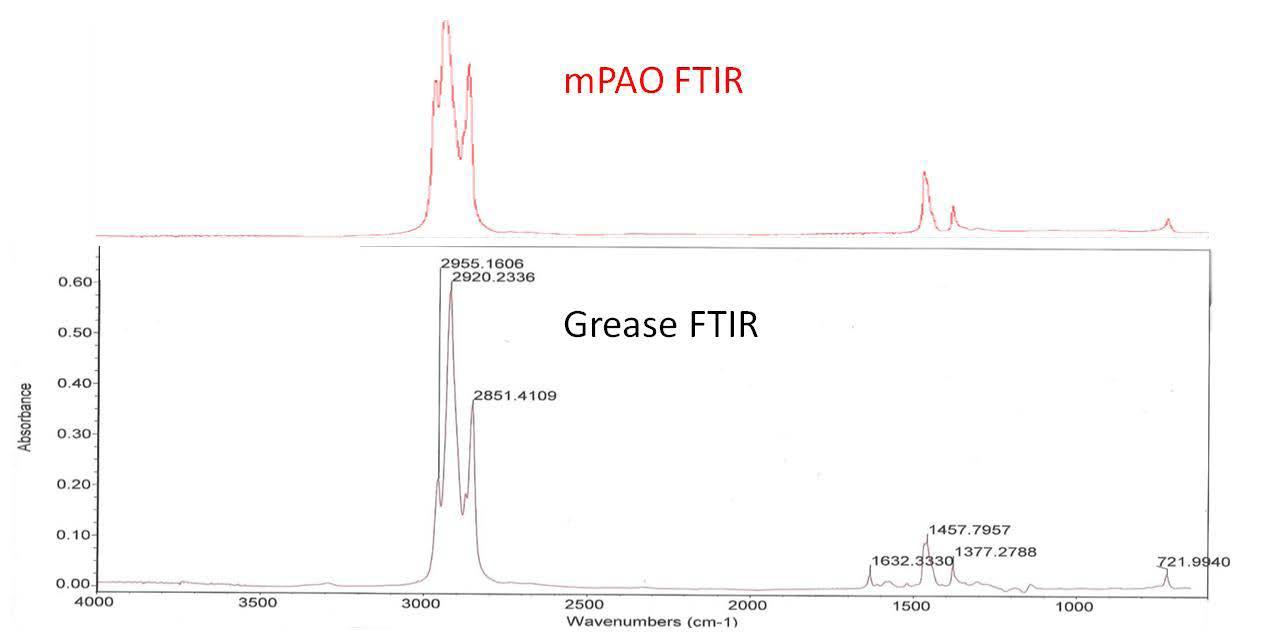
Figure 2 FTIR spectra of mPAO (top) and polyurea grease (bottom)
Figure 2 shows the FTIR spectra of the neat mPAO 65 and the polyurea base grease. Both spectra clearly depict a hydrocarbon as evidenced by the asymmetric and symmetric stretching vibrations of the C-H bonds at 2955, 2920, and 2851 cm-1 and lower energy transitions at 1457, 1377 and 721 cm-1 .
The peak at 1632 cm-1 is the response from the polyurea thickener and this is also noticeably absent from the neat mPAO 65 trace. The very minor baseline shift between 3000 and 3500 cm-1 is most likely due to the secondary amine N-H stretch from the polyurea, which is usually a broad weak peak. Nevertheless, the peak at 1632 cm-1 clearly indicates the presence of polyurea.
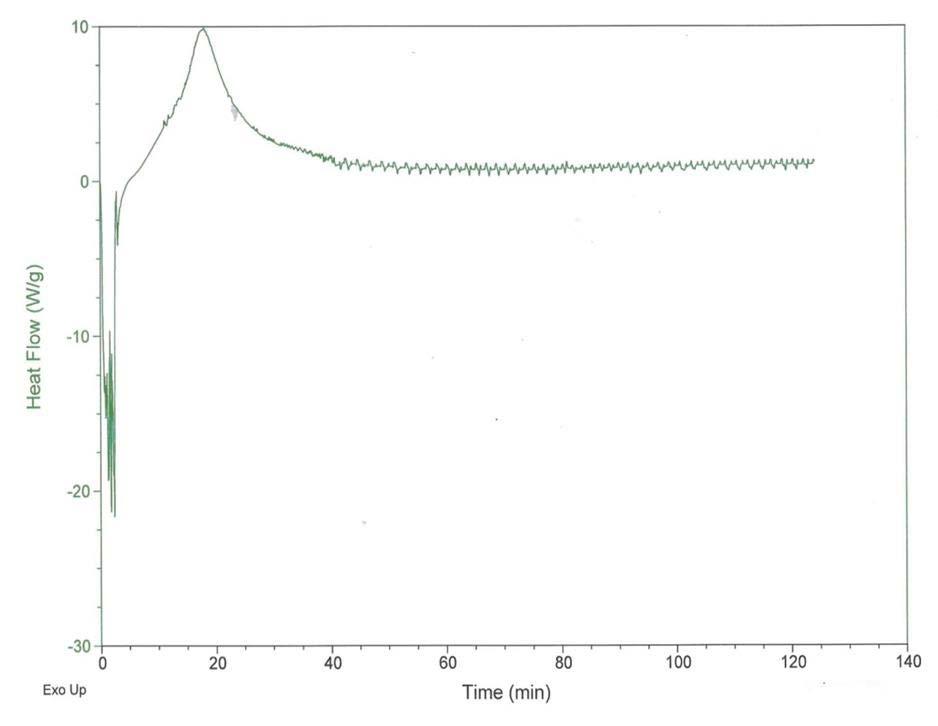
Figure 3 Pressurized Differential Scanning Calorimetry (PDSC) scan of the polyurea grease
Figure 3 shows the PDSC results of a measurement to determine the intrinsic thermo-oxidative stability of the grease. This work was conducted at 180ºC in an atmosphere of pure, dry oxygen maintained at 3500 kPa. Although the exotherm occurred after 14.5 min, it is a minor peak and does not indicate significant degradation. Subsequent microscopic inspection of the grease indicated discoloration and not catastrophic degradation. When the grease was inspected under a microscope, it remained pliable when probed with a dental pick. Greases that degrade completely during PDSC testing typically liberate 400 W/g with only carbon remaining. The FTIR and high dropping point results indicate a fairly stable grease with regard to thermo-oxidative behavior.
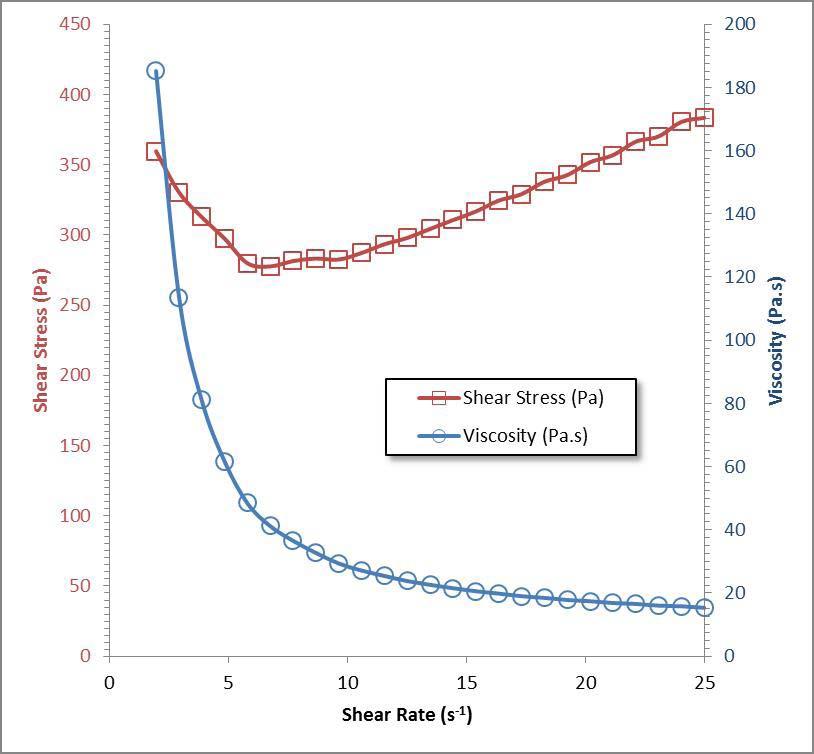
Figure 4 Apparent viscosity of polyurea grease as a function of shear rate
Figure 4 illustrates the shear thinning behavior of the polyurea base grease as a function of shear rate determined at 25ºC. Over a shear rate of 23 s-1 the apparent viscosity of the grease declines 169,850 mPa.s.
Since fretting wear [11] occurs due to the inability of a lubricant to gain access to the contact zone in general, greases that shear thin are more likely to be drawn into the contact and reduce the wear.
It is expected that the reduction of the viscosity due to the shear thinning behavior of the mPAO 65 grease could provide some protection against fretting wear. This is based on the assumption that lower viscosity greases would penetrate into the contact areas needing lubrication more readily than higher viscosity materials.
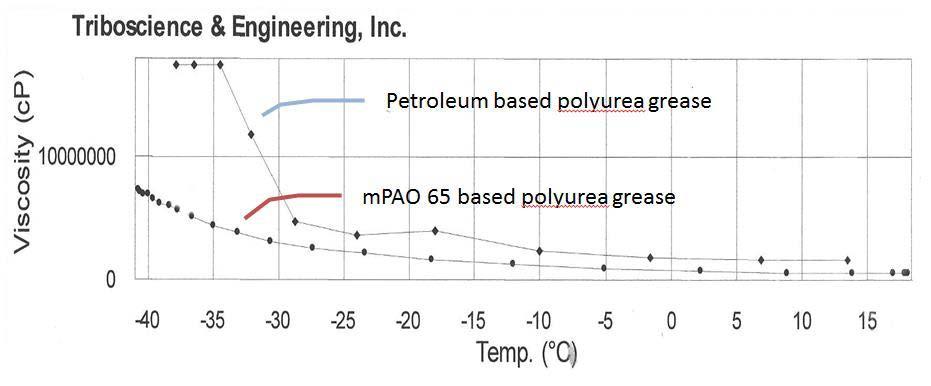
Figure 5 Apparent viscosity measurements for petroleum based polyurea grease (top) and mPAO 65 based polyurea grease (bottom)
Figure 5 compares the low temperature apparent viscosity of the mPAO 65 grease versus a petroleum based grease. These data were obtained using a Brookfield viscometer and a T-C spindle rotating at 1 rpm. Readings were automatically recorded at a fixed spindle depth. Cooling was accomplished using a Tenney Chamber programmed to -45ºC. The Tenney Chamber is shown in Figure 6.
Figure 6 Tenney Chamber for temperature controlled apparent viscosity measurements
The low temperature rheological data clearly demonstrates the superior behavior of the mPAO 65 based polyurea grease below -30°C. The petroleum grease is formulated with an ISO 220 mineral base fluid and formulated to an NLGI 2 grade consistency as well. Better low temperature flow characteristics will allow the polyurea grease to function better at low temperatures. Therefore, the grease may be suitable for applications over a wide temperature range.
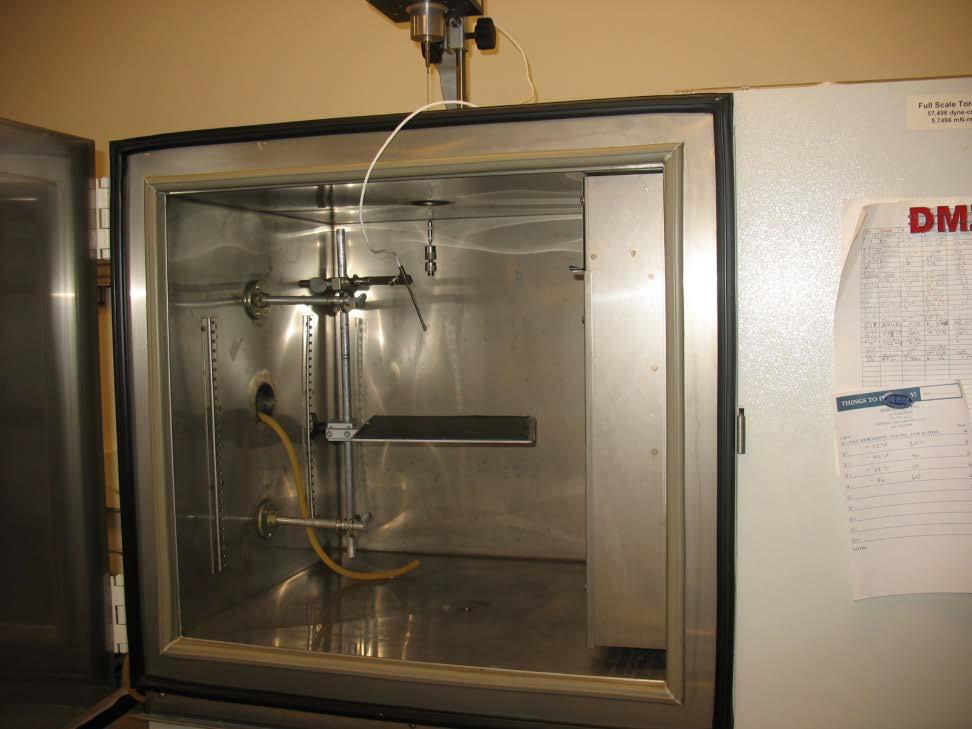
The thinning in the apparent viscosity upon shear stress in Figure 4 is most interesting. This is important since the thixotropic nature of the polyurea grease allows for penetrating into gaps between critical moving parts during operation and, once shear stress is reduced, then the viscosity returns to a normal grease consistency.
The viscometric properties of the mPAO 65, specifically the viscosity index of over 180, coupled with the thixotropic nature of the polyurea thickener provides an excellent combination of properties. These properties will allow facile delivery of the lubricating grease to the parts that require lubrication. One example of where this would be beneficial relates to fretting corrosion. Under fretting corrosion conditions, lubricant is usually precluded from entering the inlet and the contact starves for lubrication. Greases that are prone to soften with shear are more likely to enter the contact zone and surfaces are less likely to undergo fretting damage.
Conclusions:
A polyurea grease was formulated successfully using a preformed polyurea thickener and mPAO 65. Twenty percent thickener was required to produce an NLGI Grade 2 grease. The dropping point of the grease exceeded 260ºC
Oil separation from the grease was 1.03% after twenty-four hours at 100ºC.
Although the formulation contained no yellow metal passivator, the grease demonstrated ability to prevent copper discoloration during 24 hours at 100ºC.
Under microscopic inspection, inhomogeneities were observed in the grease. However, a blend of base fluids that would reduce the aniline point of the mPAO 65 would likely result is a smoother microscopic appearance.
The grease exhibits significant shear thinning which is a desirable rheological attribute for application where fretting occurs. polyurea thickener and mPAO 65 base oil can be used to produce a grease with viable properties. This formulation avoids the use of other more hazardous chemicals in the preparation of polyurea grease. This simple formulation of the thickener and base oil can naturally be improved with the use of specific additives, but this base grease provides a blank canvas for future developments with preformed polyurea thickened greases.
Acknowledgements:
The Authors would like to thank Chevron Phillips Chemical Company LP for supporting the work in this paper. We would also like to thank Mary Moon from NLGI for constructive conversations.
References:
[1] Bryant, W.C., Frost Jr., H., “Grease and Grease Base” US Patent 2,594,286, 1952.
[2] Bryant, W.C., Giordano, A., “Grease and Compounds for Making Same and Other Compounds” US Patent 2,604,449, 1952. [3] Brannen, C. G., Swakon, E.A., “Aryl-Urea Thickened Greases” US Patent 2,710,839, 1955.
[4] Polishuk, AT, “A Brief History of Lubricating Greases” pages 727-752, Llewellyn & McKane Inc. PA, 1998
[5] NLGI Lubricating Grease Guide, Fourth Edition, page 2-16, 1996.
[6] http://ivanhoeindustries.com/pdfs/press/ PreformedThickeners.pdf
[7] Rasp C., Timmermann R., Perrey H., Lehmann B. and Kussi S. “Process for the Preparation of Polyurea Greases“, US Patent 5,314,982, 1994.
[8] Rudnick L. R. “Synthetics, Mineral Oils, and Bio-Based Lubricants Chemistry and Technology”, CRC Press, Taylor & Francis Group, Second Edition, page 4, 2013.
[9] Hope K., “Polyalphaolefin Lubricant Applications” ASM Handbook, Vol 18, Friction, Lubrication, and Wear Technology, George Totten editor, page 207, 2018.
[10] Bessette P. and Hope K. “Synthetic Grease Formulated Using PAO 6 and mPAO 65”, NLGI Annual Meeting, Hot Springs, VA, June 12, 2016.



